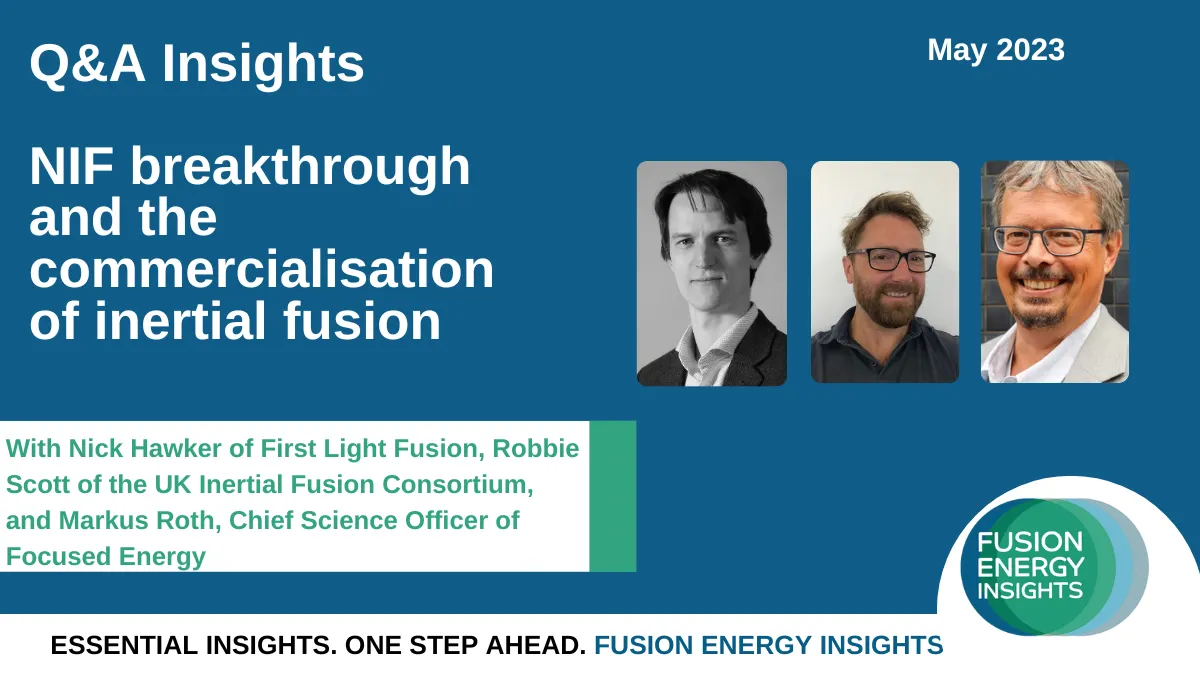NIF breakthrough and the commercialisation of inertial fusion
For our Insights Q&A in May we invited Nick Hawker of First Light Fusion, Robbie Scott of the UK Inertial Fusion Consortium, and Markus Roth, Chief Science Officer of Focused Energy to share their perspectives on the NIF breakthrough and the commercialisation of inertial fusion. Please note that Markus kindly replaced CEO Thomas Forner at short notice.

The NIF announcement of energy gain in December 2022 was a milestone achievement for the fusion community. In this session we get a view on the significance of the breakthrough from three different perspectives—one academic and two private companies who are looking to commercialise inertial fusion in very different ways.
As usual, here are three insights from the event.
1. The NIF result is an important proof of principle for inertial fusion…
but has also had the result of making some key people and skills available for private industry.
Robbie Scott: “Whilst on some level we always knew that inertial fusion worked at large scale, there was some potential doubt. You know, maybe there was some physics we'd missed at very small scaling, and maybe the alpha particle deposition range was wrong or something like this…. The result from NIF essentially shows that we understand the physics of ignition and the implosion physics pretty well. It's an excellent proof of principle.”
Nick Hawker: “We have that data point now, which says ‘it works here’. So, for our designs, we are well on the other side of that line. We’re taking all of that learning and then applying it. The physics pathway to high gain, I think, is quite clear.”
Markus Roth: ‘This is for us not only important because the physics has been demonstrated, but also a lot of the people who have been working hard on that are now looking for the next big goal. They’re thinking, from a great scientific result how we can make something that is valid for mankind? And that was the reason a lot of people from Livermore and Rochester have, meanwhile, joined Focused Energy.”
2. Private companies won’t need such precise, expensive targets (fuel pellets) as NIF used
Private company approaches and target designs will be less sensitive to target imperfections, so that they will be able to mass produce targets containing fusion fuel at a price that will make their electricity competitive.
For example, the more energy you have as an input and the higher gain your target is (i.e. the more energy you get out), the less sensitive you will be to small imperfections. (First Light Fusion) Equally, a thicker shell and lower implosion velocity, also reduce the sensitivity to imperfections. (Focused Energy)
Markus Roth: “We are not really that concerned because we do not need the perfect spherical symmetry and things like that. As we are going for lower velocities on the in-flight for the same laser energy, we can use a much thicker target, which means that if there is an instability developing it takes a lot more time to break through. And therefore the conditions of our target are relaxed compared to the NIF requirements.”
Nick Hawker: “The the journey of the field will be in a direction of more robust designs. It will still be exacting tolerances, but it won't be the NIF nanometers-smooth requirements.”
3. Laser inertial fusion is substantially simpler than a magnetic fusion concept like a tokamak
Robbie Scott: “The challenge for me with magnetic fusion is the fact that that very highly complex technologies is directly adjacent to this harsh fusion plasma, which is emitting lots of neutrons which will irradiate the superconducting magnets. And the geometry is very complex, making it hard to perform maintenance. In contrast, with laser fusion, you have this very large chamber with a very small target at the centre of it, and then you can focus lasers from some distance. [The NIF chamber is 10 meters in diameter.] So what that means is that the fusion plasma is physically separated from the chamber, so there's the potential for reduced neutron damage and thermal damage.”
There are still challenges. These mainly relate to the fact that you have pulses of emission, which means you have extremely high fluxes at the the inner surface of the chamber, but only for very brief amounts of time. And then you have to make sure your final optics can withstand the neutron radiation. The current expense of the lasers is another factor.
At First Light Fusion they are trying to find something even simpler again to circumvent some of these issues.
A full pdf summary of insights, plus the Q&A event replay, is available to members of Fusion Energy Insights. Join us now for full access to all the insights.
